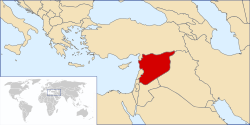Syria: New Evidence Military Dropped Cluster Bombs
New evidence has emerged that the Syrian air force has used cluster munitions in recent days, Human Rights Watch said today. Many of the strikes were near the main highway that runs through Ma`arat al-Nu`man, the site of a major confrontation between government and rebel forces this week.
Videos posted online by Syrian activists on October 9-12 showed cluster munition remnants reportedly in or near the towns of Tamane`a, Taftanaz, al-Tah, and Ma`arat al-Nu`man, in the Northern governorate of Idlib, Eastern Bouwayda and al-Salloumiyyeh in Homs governorate, Tel Rifaat in Aleppo governorate, the countryside in Lattakia governorate, and Eastern Ghouta, near Damascus. The cluster bomb canisters and submunitions shown in the videos all show damage and wear patterns produced by being mounted on and dropped from an aircraft. Residents from Taftanaz and Tamane`a confirmed in interviews with Human Rights Watch that helicopters dropped cluster munitions on or near their towns on October 9. Human Rights Watch does not yet have any information on casualties caused by the recent cluster munition strikes.

“Syria’s disregard for its civilian population is all too evident in its air campaign, which now apparently includes dropping these deadly cluster bombs into populated areas,” said Steve Goose, arms director at Human Rights Watch. “Cluster bombs have been comprehensively banned by most nations, and Syria should immediately stop all use of these indiscriminate weapons that continue to kill and maim for years.”
Human Rights Watch is deeply concerned by the risks posed by the unexploded submunitions to the civilian population, as men and even children can be seen in the videos handling the unexploded submunitions in life-threatening ways.
At least 18 videos have been posted on YouTube by Syrian activists showing the aftermath of the cluster munition strikes in recent days. They are the latest in a continuous stream of videos showing ongoing fighting, and the Human Rights Watch interviews with residents of two of the affected towns corroborate the use of cluster munitions. Eliot Higgins, who blogs on military hardware and tactics used in Syria under the pseudonym “Brown Moses,” compiled a list of the videos showing cluster munition remnants in Syria’s various governorates. Human Rights Watch reached residents in Taftanaz and Tamane`a who confirmed the strikes on their town, but has not been able to reach residents in the other towns featured in the online videos.
Human Rights Watch has confirmed that the remnants shown in the videos are RBK-250 series cluster bomb canisters and AO-1SCh fragmentation bomblets. Jane’s Information Group, a publishing company specializing in military topics, lists Syria as possessing RBK-250/275 and RBK-500 cluster bombs. These cluster bombs and explosive submunitions are Soviet-made, but there is no information available on how or when Syria acquired them.
In July, Human Rights Watch identified an RBK-250 series cluster bomb canister and AO-1SCh bomblets, apparently found in Jabal Shahshabu, Hama province, from a video. Video footage posted in August from Talbiseh in Homs governorate and from Abu Kamal in Deir al-Zor governorate also show cluster munition remnants. The August cluster munition strike on Abu Kamal appears to have involved a different type of submunition, the PTAB 2.5M, which is an anti-tank bomblet.
A resident of Taftanaz told Human Rights Watch that Syrian forces had been attacking the town for the past six weeks and that on October 9 a helicopter “dropped a [bomb] and as it fell it broke into half and released smaller [bomblets]. I heard one [initial] explosion. But after the submunitions were released I heard several [further] explosions.” The strike hit a field of olive trees south of Taftanaz, two to three kilometers from the airport. There were apparently no casualties. The resident said he saw around 30 unexploded bomblets when he went to the site.
